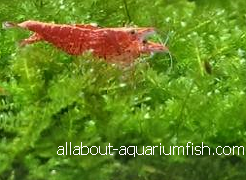
The First Step: Basic Tank Setup
Depending on which species, the most easy-to-care for recommended for beginners would be the Red Cherry Shrimps (RCS). They can tolerate tropical water living condition with the temperature ranging between 25 up to 27 deg Celsius and your tank must have plenty of live aquatic plants and moss growing in it which becomes the grazing spot for your pet shrimps. To set up the ideal environment, basically what I would suggest is that you will need to have the one of the main ingredients which is ADA substrate. Don’t worry if you can’t afford buying it as it can quite expensive but what you can actually do is to mix them with some fine sand which you can get it for cheap. The special substrates which can be bought online contain the proper nutrient to support plants healthy growth. Apart for that, ensure that you have a proper lighting system in place because these are needed not only for your growing moss but also to ensure that you shrimps develop bright coloration. Apart from java fern or moss, you can use “water sprite” which is basically a hardy plant which can regenerate quickly without the need of CO2 system. In fact, most established systems that I’ve maintained will do just fine without artificial addition of CO2.
A two feet aquarium tank can support growing population of shrimp up to few hundreds provided that you have a stable, fully-cycled system equipped with an efficient filtration setup that supports beneficial bacteria to absorb the bioload. If you find that nitrate level is too high, you can add some duckweed to absorb the excess nutrient and take it out from the water. The ideal nitrate level should not cross 10ppm level. Overall, depending on how you balance the nitrate generation and take-off rate, a small, simple tank setup with only plants and shrimps can be self-sustainable because the low amount of bioload generated by the shrimp can be easily absorbed and converted by the beneficial bacteria into fertilizers for your plants. If you have desire to set up a community aquarium, you can even consider adding only male guppies as both the fish and invertebrate can co-exist with each other just fine. Avoid female guppies as they will multiply and crowd the aquarium, something which you want to avoid as your main attraction here is still the shrimp and not the fish. Other option would be rasbora or some of the other South American Tetra which of course the best option would be neon fish.
Breeding and Propagation
Provided that you have the right tank setup, dwarf shrimps will multiply and breed by themselves and soon enough, you will start to see shrimplets. If your intention is to collect as much as possible of these little shrimps to sell it off and make some money, it would be a good idea to create a single-species tank minus the fish. These will ensure low predation and allow most of the tiny young offspring to survive. As mentioned earlier, there are two genera involved here. To maintain a specific strain with the desired characteristics, avoid mixing shrimps with members classified under the same genera. The purpose is actually to avoid interbreeding (like for example a cross breed between a Yellow Shrimp (Neocaridina heterpoda) and Red Cherry Shrimp (Neocaridina denticulate) which will end up producing offsprings with some undesirable characteristic. However, if you mix together species from different genera like for example, Crystal Red Shrimp (Caridina cantonensis) and Red Cherry Shrimp, there should not be any problem as they will not interbreed. Use the scientific nomenclature to guide you on this as the simple rule of thumb is to avoid mixing Caridina and Neocaridina together. There are exceptions however like for instance the Malaya Shrimps (Caridina sp “Malaya”) which will not create issue on interbreeding even when they are mixed with other shrimps belonging to the same Caridina genus.








